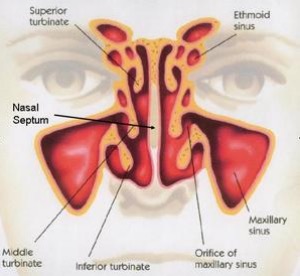Having a blocked nose is extremely common. Often this is the result of a common cold (acute rhinosinusitis). A longer-lasting blockage of the nose due to swelling of its lining occurs very commonly, this is usually called “Hay Fever”. Hay fever is a seasonal type of rhinitis, and is due to allergy to grass and tree pollens. Patients react to the pollen which causes a swelling of the lining of the nose. They also have a marked watery nasal discharge and sneezing. Allergies can be tested for and treated.
Allergic type rhinitis symptoms can be present all year round. This type of rhinitis is called perennial rhinitis. In some patients swellings form inside the nose from the constant irritation, these are called polyps. Due to the shape of the inside of the nose, these swellings become pear-shaped, and gradually get bigger, causing nose blockage.
The nose is divided into left and right sides by the nasal septum. This septum is not always in the midline. If it is over to one side, it is referred to as a deviated septum. This problem can either cause or make worse any blockage of the nose. Occasionally trauma to the nose or previous surgery may make some parts of the nose collapse, these problems usually require surgery to correct. Mr Repanos offers new surgical techniques that enable minimal discomfort, swelling and reduced time off work/school.
Why does a Blocked Nose occur ?
We do not really know why some people become allergic to things. However, allergies tend to run in the family: there is often a family history of hay fever, asthma or eczema. The deviation of the septum may be due to some previous injury, or simply the way in which the nose has grown. Collapse of the other nasal structures may have occurred from trauma, previous nasal surgery or be development in nature (just the way the nose has grown).
